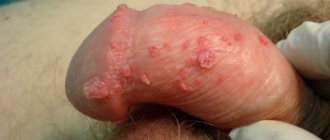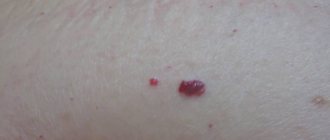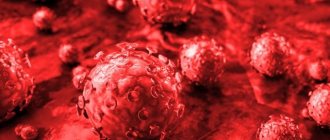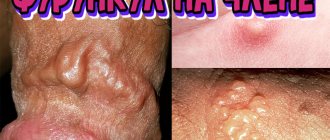Papilloma is a collective name for benign formations that appear on the surface of the skin and mucous membranes; they are classified as a warty type of rash. The appearance of these neoplasms is associated with the presence of papillomavirus in the human body. In modern medicine, about a hundred types of HPV are known, 40 of which manifest themselves primarily in the genital area. Despite the absence of a direct threat to human life and health, papilloma on the penis must be treated in a timely manner. Treatment methods and methods of getting rid of papillomas depend on the degree of pathology and the general condition of the patient.
How the virus is transmitted
Benign tumors can appear in different parts of the body: arms, face, neck and genital area. Genital warts appear on the penis, resembling a mushroom in shape. You can become infected with the HPV virus through the following ways:
- sexual contact, including oral or anal intercourse;
- when kissing an infected person (the virus is transmitted not only through blood, but also through saliva);
- household contact or use of personal hygiene items by several people at once.
Sakania Luiza Ruslanovna
Dermatovenerologist, cosmetologist, trichologist
Ask a Question
Often a person is a carrier of the virus; there are no papillomas on the male organ, but it can also infect other people. Skin formations appear with a sharp decrease in immunity, it is at this moment that the sick person develops small shoots. If there are small wounds or scratches on the skin, the virus can also enter the blood through them.
What does affected skin look like?
The disease can be identified by the appearance of small tumors on the genital organ. Most often they are pale pink in color and slightly elongated or flat in shape. First, whitish papillomas appear on the head of the penis, then move to the frenulum and foreskin. A more advanced stage of the disease is the spread of tumors into the urethra. Refusal of adequate treatment threatens not only the growth of papilloma on the head of the penis, but also in other areas. Growing growths on the penis can resemble white or brown cauliflower. You can notice warts near the anus. Contacting a specialist in this case is a mandatory measure.
Growths on the penis often interfere with personal hygiene, so particles of smegma and urine sometimes accumulate under the foreskin. Further, various infections and inflammatory processes, as well as erosion, may appear.
Genital warts are flesh-colored or pink and appear several months after contact with an infected person. Once they appear, they are small in size and have a smooth surface. As the virus spreads, they begin to affect larger areas. The color changes to bright and the surface becomes rough.
What is it and its sources of infection?
What kind of disease is this, how does it manifest itself, and what do these manifestations look like?
As a rule, papilloma is a new growth on the skin. Its shape and size can be different (from flat, slightly flattened, plaque-shaped, to sharp). The structure is usually loose, and in appearance the formation resembles a miniature cauliflower inflorescence, a wart, a kind of “bouquet” of elongated skin growths or a small cockscomb. What types of tumors on the penis can be:
- Papillomas on the head are small white-pink formations that resemble skin rashes. You can see exactly how they look on the Internet by simply typing in any search engine the query “papillomas on the glans penis photo”;
- On the trunk is one of the most dangerous types of this infectious disease. Their growth contributes to the development of cancer. At first, neoplasms appear small, but increase in size extremely quickly;
- On the frenulum - they may look like so-called wen, small light-colored pimples arranged in an orderly manner, several in a row;
- On the foreskin - they appear in the form of acute condylomas, with a light and oval body, a thin leg and slightly darker than the body of the condyloma itself. However, if nothing is done with these growths, they can grow and become similar to warts with a surface in the form of a cauliflower inflorescence;
- In the urethra - a type of papillomas that form not externally, on the skin, but internally, on the mucous membrane. They can also result in extremely dangerous and possibly even irreversible consequences - they can degenerate into an oncological tumor.
Papillomas on the penis, what are the reasons for their appearance? Naturally, these neoplasms appear on the male genital organ for a reason. They are provoked by a virus that has a very specific name - human papillomavirus. This infection is transmitted sexually - through sexual intercourse unprotected by a barrier contraceptive. But medicine also knows cases of transmission of the causative agent of a disease from an infected person to a healthy person in everyday life, say, through the same hygiene items or linen (including bed sheets and towels).
Papillomas caused by this virus do not always form on the skin immediately after the infection enters the body. And if a man’s body is completely healthy and not weakened by any other external or internal factors, then neoplasms caused by HPV may not be seen for a very long time. The fact is that the immune system of the human body is able to “work” with this virus. She is not capable of killing him completely, but she is quite capable of “driving” him into a fairly deep “hibernation”. And then the disease becomes chronic.
The virus will lie dormant in the human body, as they say, for the time being. Until a certain provoking factor appears that causes a weakening of the body’s immunity. Because of this, the disease transforms into a relapsing phase. And then papillomas can begin to grow like mushrooms after rain.
List of factors that can provoke the formation of papillomas on the penis:
- Long-term antibiotic therapy;
- Infection with other sexually transmitted diseases;
- acute respiratory infections or acute respiratory viral infections in severe form;
- Severe and prolonged stress or nervous strain;
- Switching to hazardous production that negatively affects general health;
- Hormonal disorders;
- Severe hypothermia that occurs systematically;
- Bad habits - constant drinking and smoking.
Symptoms and methods of detection
Signs of the disease may differ depending on the stage of the disease and the individual reaction of the body. But the most common occurrence is the following:
- severe itching or burning in the affected area;
- skin redness;
- You may notice a slight swelling near the affected area;
- the skin becomes dry, small cracks appear;
- sexual intercourse is accompanied by painful sensations;
- release of blood or pus if the papilloma on the head of the penis is damaged (this provokes infections).
How to remove papillomas on the penis if one or more symptoms are detected? You should consult a doctor as soon as possible. This disease is dealt with by a urologist and dermatologist. First, the doctor must interview and examine the patient. Then you need to take a blood and urine test to identify other infectious diseases. The PCR test will help determine the type of tumor, which will have a positive effect on the speed of treatment. If a malignant tumor is suspected, the growth tissue is sent for biopsy. The patient may also be prescribed a smear from the genitourinary tract if there is pain.
Leading doctors
- Votyakov Evgeniy Olegovich
Operating urologist, urologist-oncologist
Danube Ave., 47
- Ter-Avetikyan Avetik Zareevich
Urologist
st. Marshala Zakharova, 20, Vyborg highway, 17-1
- Privalov Dmitry Vladimirovich
Operating urologist
Udarnikov Ave., 19, st. Marshala Zakharova, 20
- Sergienko Andrey Yurievich
Operating urologist
Danube Ave., 47, Vyborg Highway, 17-1
- Abramova Marina Vladimirovna
Urologist-andrologist, urological surgeon, pediatric urologist
Udarnikov Ave., 19, Danube Ave., 47, st. Marshala Zakharova, 20
- Dolobeshkin Dmitry Sergeevich
Operating urologist
st. Marshala Zakharova, 20
- Dushenkov Konstantin Damirovich
Operating urologist
Udarnikov Ave., 19, Danube Ave., 47
- Zhuravsky Dmitry Alexandrovich
Danube Ave., 47, st. Marshala Zakharova, 20
View all
- Shelkovaya Olga Vladimirovna
Dunaysky Ave., 47 - Ustinov Pavel Nikolaevich
Danube Ave., 47
- Burdeyny Alexey Alexandrovich
Danube Ave., 47
- Pavlov Roman Alexandrovich
Danube Ave., 47
- Popova Olga Alexandrovna
Vyborg highway, 17-1
- Radionov Ivan Sergeevich
Udarnikov Ave., 19
- Shlensky Daniil Sergeevich
Udarnikov Ave., 19
Hide
Danger of disease
The appearance of small genital warts is dangerous not only for a man, but also for his sexual partner. Small papillomas on the penis consist of many vessels that, when damaged, release blood. If unprotected intercourse occurs, a woman may become infected through this blood. Growths, which are often subject to injury and damage, bring pain to a person. At the same time, they often degenerate into a malignant tumor, which poses a danger to human health.
Papillomas on the head of the penis lead to consequences not only for the man, but also for his family. Often, the wife and even children become infected with the disease through everyday contact. When a woman is infected during pregnancy, the virus passes to the child during childbirth in almost all cases. Women run the risk of getting a virus from such a man, which will manifest itself in the form of growths on the genitals. They are also the cause of a malignant tumor of the cervix or mammary glands. Children infected during childbirth suffer from growths on the mucous membranes in the mouth or nose. Papillomas can only be cured by surgery. Therefore, it is important to undergo examination for both the man and his entire family in order to identify the problem at an early stage.
Risk of cancer with papillomas on the head
The most serious health risks are associated with malignant degeneration of papilloma.
HPV is one of the main causes of penile cancer in men.
However, the disease itself is not that common.
In the world, about 5% of all cancers are caused by papillomavirus.
In approximately 75% of cases, tumors are localized in structures of the reproductive system.
Most of these processes occur in cervical carcinoma.
But penis cancer also sometimes occurs in men.
In addition, there is evidence that human papillomavirus infection increases the risk of prostate cancer.
Therefore, every man with papillomas should be under medical supervision.
Regular screening examinations are necessary to identify the first signs of malignant processes.
How to treat papillomas on the penis
The most effective treatment methods are surgical removal of penile papillomas, needle electrodes and freezing with liquid nitrogen. It is also possible to perform laser removal of papillomas from the penis, which is a more gentle method. Statistics show that getting rid of growths on the genitals using medication is not the best idea. Various solutions help remove only small tumors, but if a large area is affected, they are powerless.
Papilloma in men in an intimate place, treatment, traditional medicine
The human papillomavirus is perhaps the most common occurrence that has occurred recently. There are more than a hundred of its variants, which lead to numerous formations on the skin. The incubation period can last from several weeks to many years.
Condylomas located on the penis are considered quite dangerous, so they should be treated as quickly as possible. Under no circumstances should this condition be treated lightly. A neglected stage can lead to quite serious consequences, and even nearby organs can be damaged. It depends on the attending physician how to treat and remove penile papillomas.
Clinical picture of the disease
The incubation period for penile papillomas is eight to twelve weeks, but this time can sometimes vary. It all depends on how strong the patient’s body is and whether he can cope with the disease on his own.
Although HPV usually causes harmless growths that do not cause harm, it is the oncogenic strains of the virus that are localized on the penis. In other words, such formations may indicate the development of a precancerous process.
Papillomas localized on the penis look like small growths and are flesh-colored. There are both single and multiple papillomas, and in appearance they look like cauliflower. If papillomas cause inguinal papillomas in the groin area of a man, then treatment should be started on time, otherwise quite serious complications may arise:
- The leaves of the foreskin begin to shrink, which means the head of the penis cannot retract fully.
- smeg begins to accumulate, which leads to infection.
- The tip of the penis will begin to ignite.
- Erosion is observed on the foreskin and head.
If papilloma in men appears in the intimate area, treatment should begin immediately. This will prevent the development of such unpleasant and dangerous complications.
Diagnostics
Do not think about how to get rid of the papilla or warts on the tip of the penis until after the examination. The most important diagnostic measures include the following:
- Study the clinical picture and make a medical history. The doctor should clarify whether unprotected sexual intercourse took place. Then you should carefully examine the genitals, anus and oral cavity, since the formation may also be localized there.
- Polymerase chain reaction. This research method is quite complex, but 95% effective. Thanks to PCR diagnostics, it is possible to determine the DNA of the virus and accurately identify the strain.
- Cytological examination. Various methods are used to detect antibodies against HPV.
How to cure a papilloma infection on the penis, the doctor will decide as soon as he determines the type of virus and the stage of the disease.
How to cure viral papillomas on the penis - main directions
Unfortunately, it is simply impossible to completely remove the human papillomavirus from the body. However, this can be controlled, which limits the emergence of new shoots, but existing ones must be removed. But how can we do this?
Papilloma in the male head area, treatment is carried out in three directions:
- Strengthening the patient's immunity.
- The fight to suppress the virus.
- All external signs of disease must be removed.
Papillomas that appear on the penis should be treated surgically - during the procedure, tumors are excised under anesthesia, and external agents help to dissolve them.
How to get rid of papillomas or condylomas on the penis using traditional methods
Men are mainly concerned about where papillomas are removed from intimate areas ? Such manipulations can be carried out in almost any medical institution. As for beauty salons, it is better not to seek help there.
So, if you are thinking about how to get rid of papilloma virus or penis enlargement, go to a hospital with experienced doctors.
Papillomas on the outside of the cavity and surgical treatment of the penis
Very large forms are removed surgically - under anesthesia they are cut with a scalpel. But along with the formation of about three centimeters of healthy skin, it is also removed. This method of treatment has one drawback - after it is performed, scars appear on the skin, and pain is felt during its implementation.
In addition to such operations, there are other methods, for example, laser or radio knife, which we will discuss below.
How to treat genital papillomas on the penis with a radio knife
The electrode can act on the skin without contact. In this method, the electrode acts like radio waves, without contact with the nodes that heat them.
The main advantage of this treatment method:
- Healthy tissue is not damaged.
- The rehabilitation period is short, and most importantly, there are no scars on the skin.
- Episodes are very rare, only occurring in 10% of cases.
How to handle a radio knife? A different frequency is used to make the cut. Thus, the knife itself does not heat up.
Papillomas or mass of the head of the penis, how do you treat with laser?
Laser treatment cuts the lesions without affecting adjacent tissue. The layer-by-layer node is removed and the depth of the wound is minimal.
Causes of facial papillomas
However, this effective method also has disadvantages and draws attention to the following:
- Pain may be felt, so patients are placed under anesthesia.
- The virus can become airborne. In this case, a secondary infection may occur.
- The doctor's skills must be sufficient to perform all these manipulations.
Everything will heal in the next five to seven days.
How to get rid of papillomas?
The most suitable method that does not leave scars on the skin is electrocoagulation. Only in the most advanced cases can pigment spots remain. Cryosurgery or liquid nitrogen are often used, as are others. With its help you can get rid of one or a whole group of skin rashes. During the procedure, the person feels slight pain and burning. The only negative is scars and ulcers at the sites of tumors. Therefore, it is not recommended to remove growths on the penis using this method.
The most popular cosmetic methods are: cryodestruction, laser therapy, freezing with liquid nitrogen. After familiarizing yourself with the pros and cons, you can safely go for the procedure without fear of negative effects.
| Method | Advantages | Flaws | How long does it take to heal |
| Use of alkali-based chemicals | Suitable for removing small growths located on the skin | Do not apply the compositions to mucous membranes; it causes burns if used incorrectly | From 10 to 14 days |
| Cryodestruction | Painless and bloodless removal of warts on any part of the body | Swelling and redness after the procedure, likelihood of tissue scarring | 4 to 6 weeks |
| Radio wave coagulation | Performed under local anesthesia and leaves no scars | Many contraindications, including suspicion of a malignant tumor | Up to 14 days |
| Laser therapy | No pain or blood during the session, quick recovery, safe technique | Many contraindications, the need to avoid visiting the bathhouse and solarium after the procedure | Up to 2 weeks |
| Electrocoagulation | There is no blood, so the chance of infection is reduced to zero | Pain, swelling and burn after removal | Up to 7-10 days |
The next method is surgical removal using a scalpel. Surgery should be performed if a malignant tumor is suspected, as well as if the tumor is large. After the intervention, scars may remain on the skin that are difficult to remove. The procedure is performed under local anesthesia, but the subsequent rehabilitation period is quite painful.
How to remove papillomas with special substances?
Removal with chemical components should only be carried out by a doctor, otherwise you can get severe burns to healthy tissue. Special products burn out the wart tissue, which then comes off. After falling off, healthy skin appears.
It is worth remembering that you cannot be sexually active immediately after removal; it is better to postpone it until the wounds have completely healed. Taking medications based on natural ingredients to eliminate growths on the body at home without removal is a stupid waste of time and money. You should take antiviral drugs before or after removing benign tumors. They help the body overcome the human papillomavirus on the penis. In addition, it is recommended to increase immunity by leading a healthy lifestyle, as well as taking a complex of vitamins.
Treatment
Since the appearance of pathological formations on the organs of the reproductive system is preceded by a decrease in immunity, complex treatment should be prescribed.
The papillomas themselves are removed either by cauterization or by surgery. Medicines that contain a component that blocks the reproduction and development of viral agents also help fight HPV. For example, Epigen-intim, Viferon, Acyclovir and similar agents can be used.
In addition to antiviral therapy, the attending physician prescribes vitamin complexes, immunomodulators and gives the patient recommendations on lifestyle and healthy eating.
It is important to identify all the factors that led to the activation of HPV and eliminate them. Therefore, before deciding which methods to use for treatment, you should undergo a health examination.
Removal methods
New growths on the penis do not disappear on their own, so the patient will need to use radical methods.
The patient may be offered the following methods of removing growths:
- Laser removal. The neoplasms are melted using a laser beam, leaving a crust at the site of their localization, which disappears naturally after 2 weeks.
- Cryodestruction. The growths are cauterized with liquid nitrogen. As is the case with the laser removal procedure, a crust remains, which after a while disappears without a trace.
- Radiosurgery. The doctor acts on the papilloma using radio waves. The method is considered the safest, most accurate and does not provoke complications.
- Electrocoagulation. The formation is eliminated using an electric current supplied at a certain frequency. The disadvantage of this method is that removing the papilloma may leave scar tissue.
- Chemical removal. The principle of the technique is to cauterize tumors with medical solutions: Solcoderm or Condolin. Drugs should only be applied by a specialist. After treatment, the growths dry out and fall off.
- Treatment with ointments. For minor growths, special ointments can be used to remove them. Aldara or Oxolinic ointment will help you cope with the papilloma virus.
How to remove papillomas on the penis, what methods of removal or what drugs to use are decided by the attending physician, based on the characteristics of the course of the disease and the health status of the individual patient.
Procedures for eliminating formations do not require the use of painkillers and in 95% of cases give a positive result. Sometimes relapses occur in the same place.
Drug treatment
It should be noted that although surgical methods are the main choice in the treatment of papillomas, to prevent reactivation of the virus, the doctor may prescribe an additional course of drug therapy.
The use of the following medications is recommended:
- Antiviral agents. Tablets, ointments and creams are used. Local application of the product helps prevent the recurrent appearance of tumors. Drugs such as Groprinosin, Panavir, Keravort, Epigen may be prescribed. It should be noted that the effectiveness of most drugs against the human papillomavirus has not been proven.
- Drugs that increase the activity of the immune system. This group includes special immunomodulators, adaptogens and vitamin complexes.
One way or another, you need to understand that you should take any action to eliminate the disease only after consulting a doctor.
An attempt to remove papilloma on your own can cause a number of complications (chemical burns of mucous surfaces or even degeneration into an oncological tumor).
Uncontrolled use of antiviral drugs without the prescription of a specialist will not bring health benefits, but only harm.
Thus, detection of manifestations of papillomatosis is a reason to immediately contact a dermatovenerologist or urologist. Only in this case can you count on a correct diagnosis and drawing up a treatment plan.
Folk remedies
The use of traditional recipes is possible in agreement with the attending physician. The following remedies are effective:
- Tea tree oil. The oil must be rubbed into the affected area daily until the wart completely disappears.
- Good results can be achieved by applying propolis to the growth.
- The easiest way is to lubricate papillomas with egg white.
- You can get rid of the manifestations of HPV with the help of vinegar, which needs to be cauterized once a day.
- You can deal with small growths by lubricating the growths with juice from rowan berries.
- You should use ammonia lotions with caution, as this can cause burns.
With the help of these recipes you can only get rid of recently appeared tumors that have not had time to grow much. If the papilloma has formed and protrudes noticeably above the skin, its removal is only possible using radical techniques.
Preventive measures
To avoid recurrence of the disease, you should follow some rules. There is a vaccine against the virus that protects 100% against the occurrence of benign tumors, as well as cancer. You can get vaccinated with Cervarix or Gardasil. There is one big disadvantage - the vaccination should only be done in adolescence.
For prevention, adults should lead a healthy lifestyle, namely:
- Healthy food;
- exercise regularly;
- toughen up and do physical exercises in the fresh air;
- stop smoking and drinking alcohol;
- observe the rules of personal hygiene;
- do not have promiscuous sex life;
- protect yourself using modern contraception.
All these rules help get rid of the disease forever. If the disease recurs, the doctor may suggest circumcision of the foreskin. This procedure prevents bacteria from accumulating in the folds of the skin, which prevents the spread of many diseases. Before curing a disease with traditional medicine, you should consult your doctor so as not to cause harm. Having repeatedly identified papillomas under the head or at the base of the organ, it is recommended in any case to consult a specialist.
Prevention
The main measures to prevent HPV infection are a monogamous relationship with a trusted partner and maintaining personal hygiene when visiting public places. Young people from 9 to 26 years old can get a vaccine that protects only against oncogenic types of the virus - Gardasil-4. The degree of protection is 97%. These vaccinations are most effective between the ages of 10 and 14 years. If the virus is already present, then vaccination is pointless. It should be noted that the drug provokes blood thickening, therefore it is contraindicated in persons with coagulation disorders and a tendency to thromboembolism.
An important protective measure is to strengthen the immune system, but not with drugs, but with a healthy lifestyle. Folk remedies to help: tincture of echinacea, ginseng, bee products.











